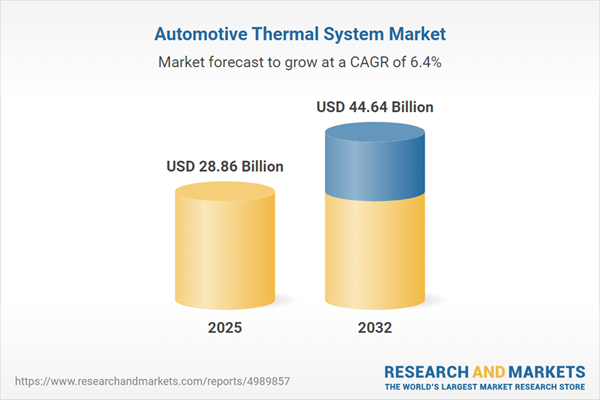Speak directly to the analyst to clarify any post sales queries you may have.
Senior executives are navigating profound transformation in the automotive thermal system market, where technological change and evolving regulations demand decisive action. Strategic access to credible, actionable insight is essential for ensuring competitiveness and informed leadership throughout these dynamic shifts.
Market Snapshot: Automotive Thermal System Market Outlook
The automotive thermal system market is projected to reach USD 44.64 billion by 2032, up from USD 27.15 billion in 2024 and USD 28.86 billion in 2025, representing a forecast CAGR of 6.41%. Elevated demand for advanced climate-control systems and increasing electric vehicle adoption propel this anticipated growth. Organizations are reimagining supply chains and operations by prioritizing digital transformation, agile manufacturing, and resilience in response to shifting regulations and market conditions. As global automotive players pivot to more sustainable and efficient thermal technologies, a focus on operational adaptability and forward-looking strategies remains key to enduring success in the sector.
Scope & Segmentation: Automotive Thermal System Market
This report offers senior decision-makers clarity on the competitive and technology landscape across all critical areas, empowering risk-aware decision-making and programmatic leadership in a rapidly evolving market context:
- Products: Focus includes radiators, heater cores, HVAC units, evaporators, and condensers—ensuring optimum thermal management, efficient operation, and enhanced cabin safety and comfort.
- Propulsion Types: Analysis covers battery electric vehicles, hybrids, fuel cell vehicles, and internal combustion engine vehicles, each requiring tailored thermal strategies aligned with efficiency and environmental objectives.
- Vehicle Types: Detailed examination of passenger cars—sedans, hatchbacks, SUVs—and commercial vehicles including buses and trucks, highlighting operational demands and application-specific benefits of upgraded thermal solutions.
- Sales Channels: Evaluation of OEM and aftermarket supplier roles, with emphasis on procurement agility, strategic sourcing, and robust inventory management to address changing compliance and sourcing landscapes.
- Regions: Geographic coverage spans North America, South America, Europe, the Middle East & Africa, and Asia-Pacific, spotlighting evolving opportunities in key markets such as the United States, Canada, China, India, Japan, Australia, and South Korea.
- Companies Profiled: Strategic outlook includes DENSO Corporation, Valeo S.A., Robert Bosch GmbH, MAHLE GmbH, Marelli Holdings, Hanon Systems, Modine Manufacturing, Sanden Holdings, Eberspaecher Climate Control Systems, and Subros Limited—emphasizing innovation, market reach, and position within the industry.
- Technological Advancements: Coverage features development of energy-efficient HVAC systems, lightweight heat exchangers, and environmentally responsible refrigerants in response to sustainability targets, regulatory adaptation, and the drive for operational improvement.
Key Takeaways: Strategic Insights for Senior Leaders
- Excellence in thermal management is essential to meet evolving vehicle efficiency and regulatory expectations while delivering user satisfaction and ensuring robust operations.
- Adopting supplier diversification and flexible manufacturing drives greater resilience against global policy shifts or unexpected disruptions within the supply chain.
- Transitioning to lighter materials helps achieve sustainability objectives and supports advantage in established and new vehicle segments.
- Enhanced digital diagnostic tools and remote system monitoring enable efficient management of large and diverse vehicle fleets.
- Integrating software, electronics, and hardware opens new possibilities for deploying thermal solutions designed for vehicle electrification and increasing automation.
- Customization of product portfolios by region is crucial for maintaining compliance with local standards and addressing operational needs across diverse markets.
Tariff Impact: North American Supply Chain Dynamics
The upcoming U.S. tariffs scheduled for 2025 are prompting automotive suppliers to reevaluate sourcing and procurement strategies. Increased nearshoring and engagement with regional supplier networks strengthens the industry's ability to adapt to regulatory changes and fluctuating trade conditions. The use of flexible contracting supports risk reduction and sustained operations for North American thermal system stakeholders.
Methodology & Data Sources
This report is grounded in comprehensive secondary research, targeted patent analysis, and interviews with senior industry executives. Data is validated by scenario-based analysis and triangulated for consistency, supporting dependable insight for executive planning in the automotive thermal system market.
Why This Report Matters
- Equips senior leaders with actionable insights to inform strategic planning amid disruptive technological and regulatory trends in the industry.
- Facilitates effective resource planning, benchmarking, and compliance management—enabling organizations to confidently guide investment and innovation decisions.
- Supports long-term growth and organizational agility as automotive market dynamics continue to evolve.
Conclusion
This analysis positions executive teams to anticipate industry shifts, steer strategic priorities, and sustain operational resilience in the rapidly changing automotive thermal system environment.
Additional Product Information:
- Purchase of this report includes 1 year online access with quarterly updates.
- This report can be updated on request. Please contact our Customer Experience team using the Ask a Question widget on our website.
Table of Contents
3. Executive Summary
4. Market Overview
7. Cumulative Impact of Artificial Intelligence 2025
Companies Mentioned
The companies profiled in this Automotive Thermal System market report include:- DENSO Corporation
- Valeo S.A.
- Robert Bosch GmbH
- MAHLE GmbH
- Marelli Holdings Co., Ltd.
- Hanon Systems Co., Ltd.
- Modine Manufacturing Company
- Sanden Holdings Corporation
- Eberspaecher Climate Control Systems GmbH & Co. KG
- Subros Limited
Table Information
| Report Attribute | Details |
|---|---|
| No. of Pages | 181 |
| Published | November 2025 |
| Forecast Period | 2025 - 2032 |
| Estimated Market Value ( USD | $ 28.86 Billion |
| Forecasted Market Value ( USD | $ 44.64 Billion |
| Compound Annual Growth Rate | 6.4% |
| Regions Covered | Global |
| No. of Companies Mentioned | 11 |









